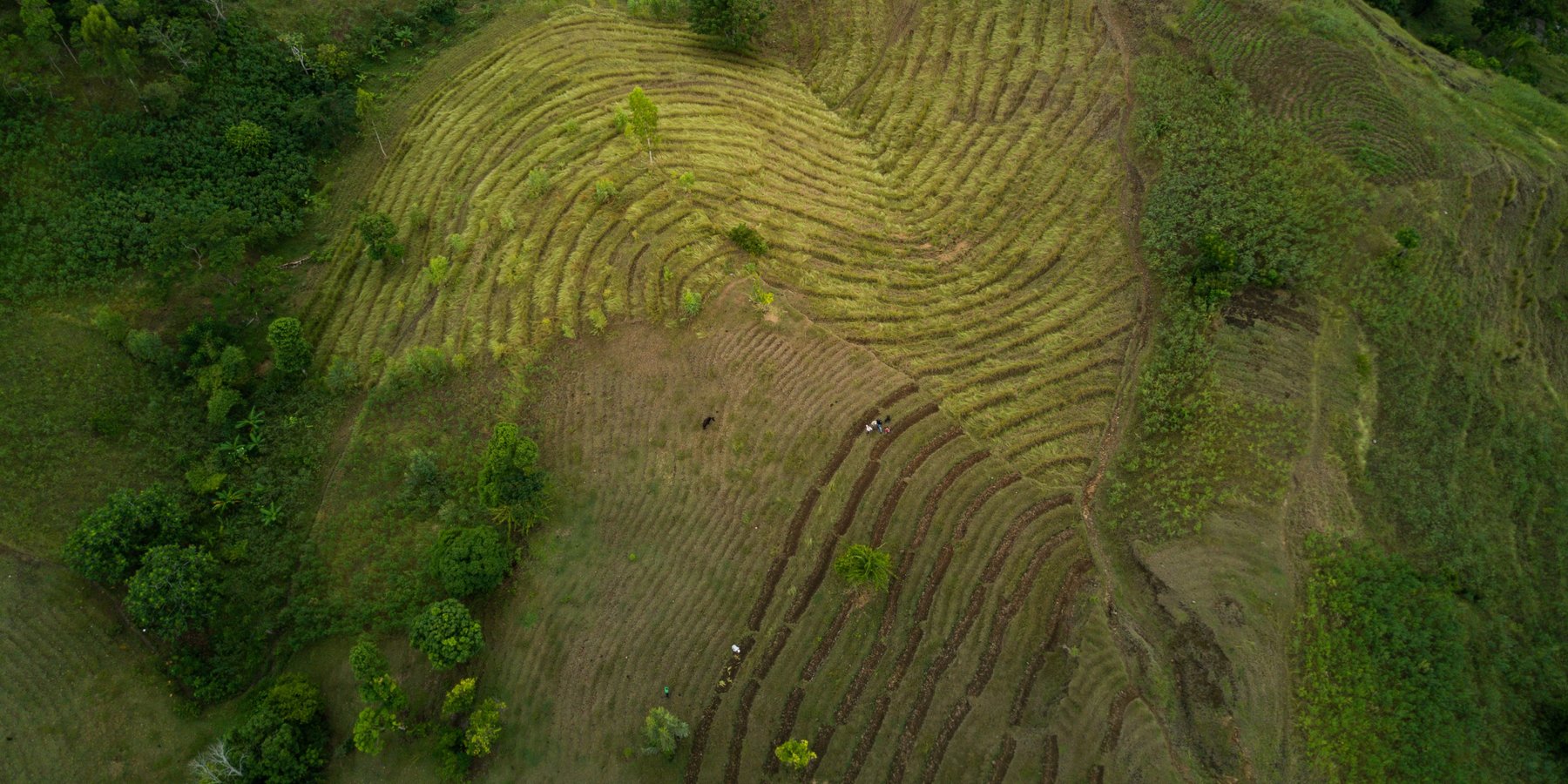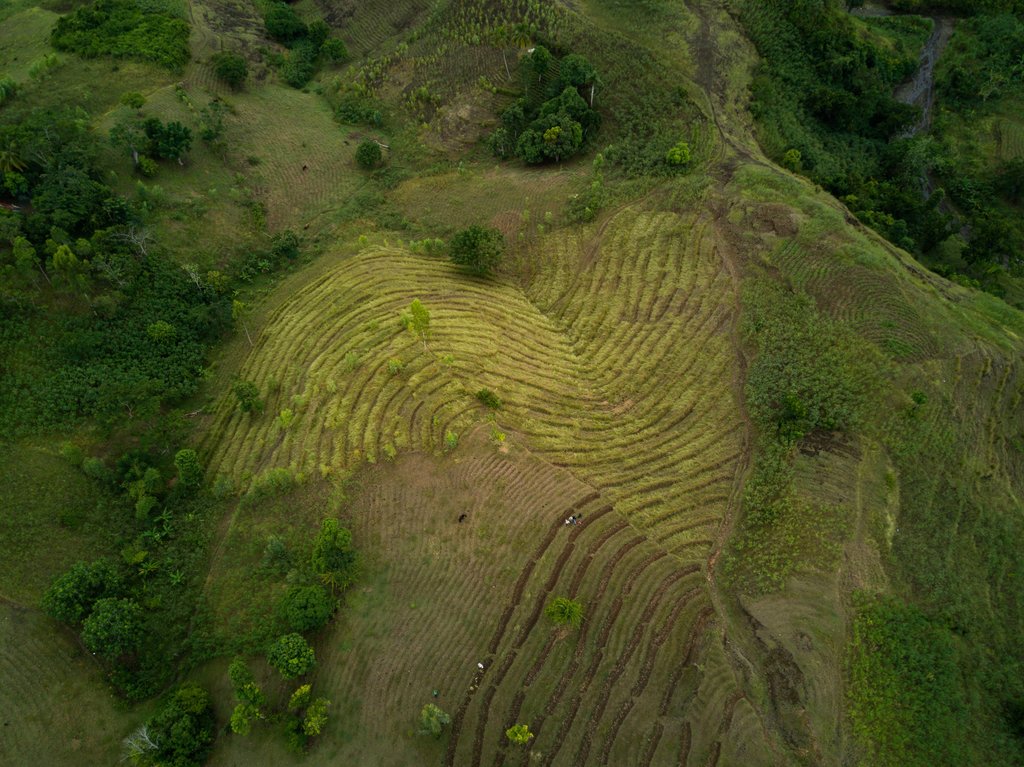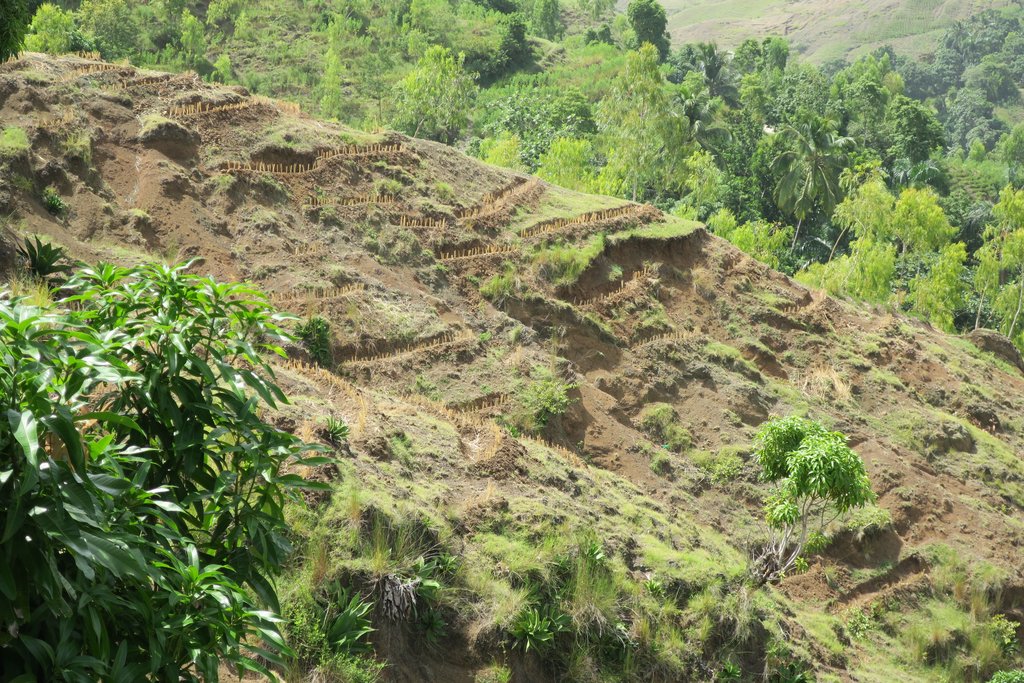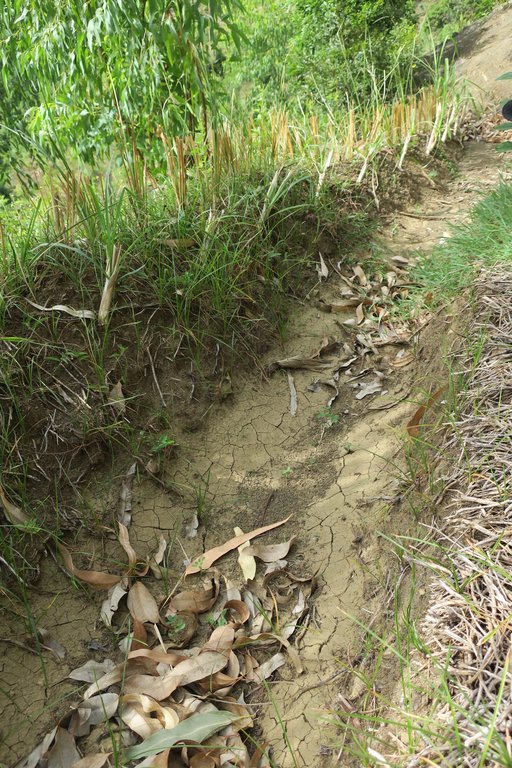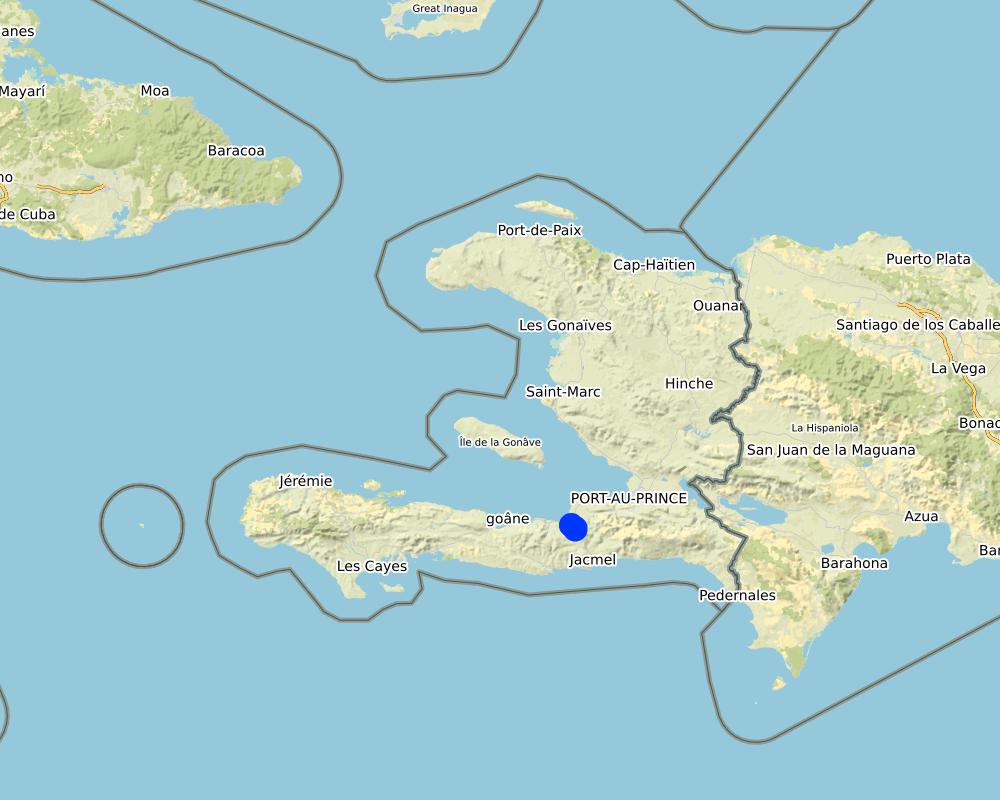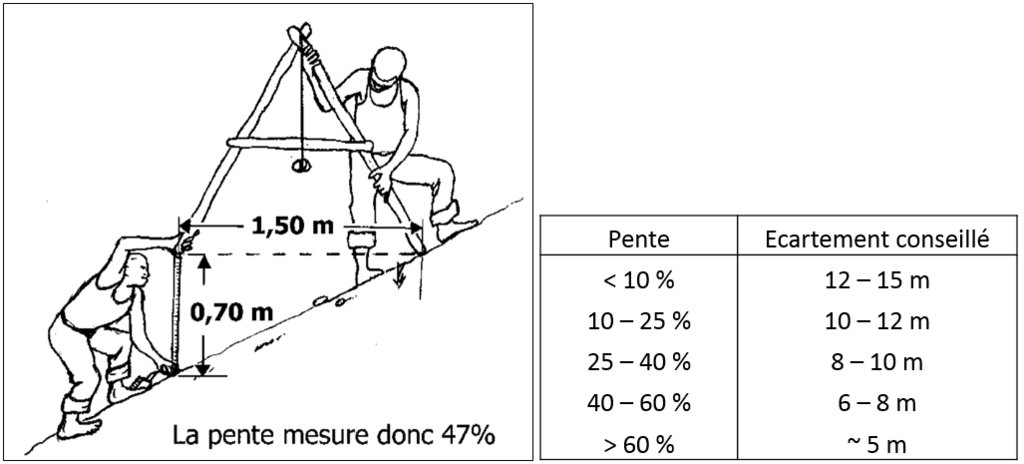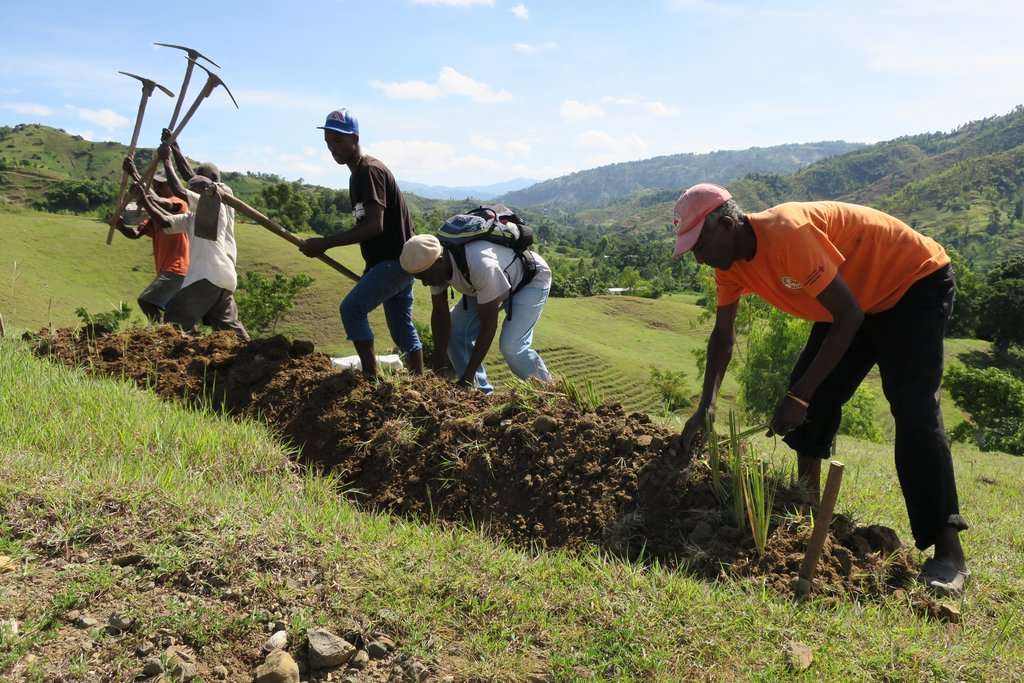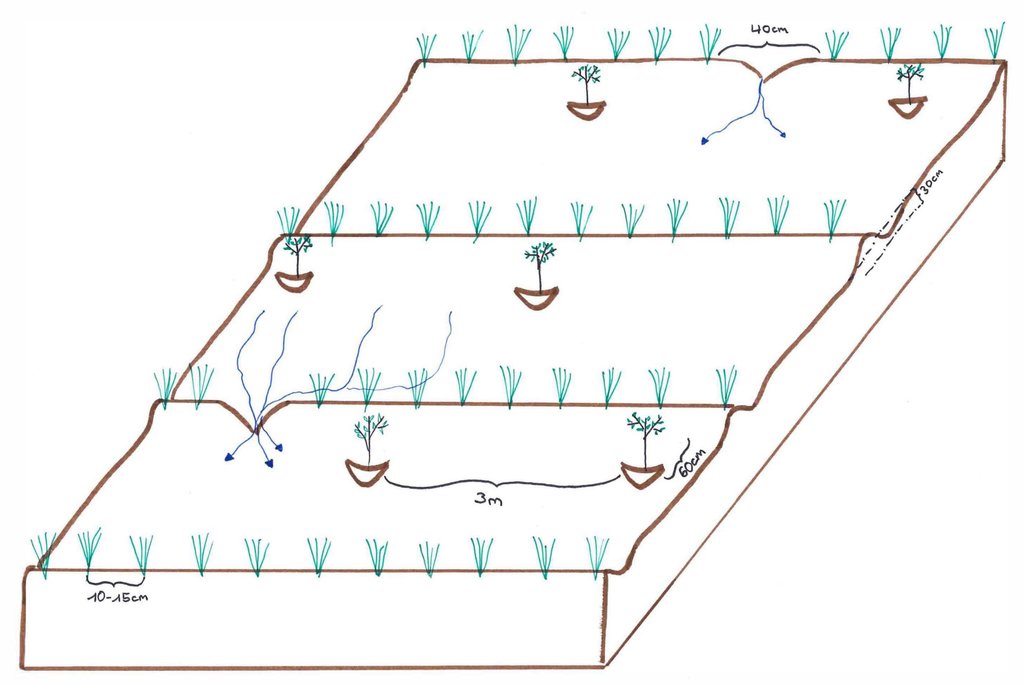Progressive bench terraces formed by a vetiver hedge system and trees [هايتي]
- تاريخ الإنشاء:
- تحديث:
- جامع المعلومات: Joana Eichenberger
- المحررون: Jean Carls Dessin, Hanspeter Liniger
- المُراجع: Hanspeter Liniger
Ranp vivan (fran. rampes vivantes)
technologies_3223 - هايتي
- Progressive bench terraces formed by a vetiver hedge system and trees: 23 فبراير، 2019 (inactive)
- Progressive bench terraces formed by a vetiver hedge system and trees: 16 يونيو، 2020 (inactive)
- Progressive bench terraces formed by a vetiver hedge system and trees: 16 إبريل، 2020 (inactive)
- Terrassement progressif à vétiver: 16 فبراير، 2019 (inactive)
- Progressive bench terraces formed by a vetiver hedge system and trees: 27 يونيو، 2021 (public)
عرض الأقسام
توسيع الكل طي الكل1. معلومات عامة
1.2 تفاصيل الاتصال بالأشخاص الرئيسيين لمصدر المعلومات والمؤسسات المشاركة في تقييم وتوثيق التقنية
Technician:
هايتي
اسم المؤسسة (المؤسسات) التي سهلت توثيق/تقييم التقنية (إذا كان ذلك على صلة)
Swiss Red Cross (Swiss Red Cross) - سويسرا1.3 الشروط المتعلقة باستخدام البيانات الموثقة من خلال WOCAT
يوافق جامع المعلومات والشخص (لاشخاص) الرئيسي لمصدر المعلومات على الشروط المتعلقة باستخدام البيانات الموثقة من خلال WOCAT:
نعم
1.4 إعلان بشأن استدامة التقنية الموصوفة
هل التقنية الموصوفة هنا تمثل مشكلة فيما يتعلق بتدهور الأراضي، بحيث لا يمكن إعلانها تقنية مستدامة لإدارة الأراضي؟:
كلا
1.5 الإشارة إلى الاستبيان (الاستبيانات) حول مناهج الإدارة المستدامة للأراضي (موثقة باستخدام WOCAT)

Afforestation [هايتي]
Dans les mornes à Léogâne, la Croix Rouge Suisse (CRS) pratique la reforestation en participation communautaire.
- جامع المعلومات: Joana Eichenberger
2. وصف تقنيةالإدارة المستدامي للأراضي
2.1 وصف مختصر للتقنية
تعريف التقنية:
Progressive terracing technology is established through successive deposits of sediments behind (upstream) any anti-erosional structure, in this case contour strips of vetiver grass (vetiveria zizanioides). To better stabilize the slopes in the long-term, trees are planted downstream of the vetiver hedges.
2.2 وصف تفصيلي للتقنية
الوصف:
Vetiver hedges are applied to prevent degradation and increase slope stabilization on areas prone to erosion. In Haiti, the Swiss Red Cross (SRC) has used cross-slope vetiver hedges as a restoration measure where soil has been degraded by surface erosion. Terraces are progressively formed and these reshape steep-sloped terrain into a succession of platforms with little or no gradient. Over time, these areas receive deposits of sediments from upstream: these sediments are captured by the terraces. Vetiver grass is used to establish anti-erosive structures because it is a common, deep-rooted species that can also be cut and used as mulch. Below the vetiver hedges, fruit trees may be planted to better stabilize the soil and simultaneously improve food security. However, if the soil is too degraded, forest trees are an alternative as they are less demanding. Between the vetiver hedges, land users can cultivate crops. It is recommended not to plant root crops (potatoes, cassava etc) or even groundnuts, but rather to plant legumes that bear fruit above ground and fix nitrogen, and perennial crops. Vetiver may be cut and used for mulching on the terrace beds.
This technology has several on- and offsite benefits. Besides stabilizing slopes and reducing landslide risks, vetiver strips are proven to reduce and retain surface runoff in ditches just above the hedges. Therefore, rainfall water can infiltrate more easily and recharge groundwater. Another onsite advantage is the accumulation of fertile sediments on the terrace beds, which support cropping. Offsite benefits include downstream protection for communities and agricultural fields against landslides, floods and siltation. Despite these advantages, land users claim there is significant loss of arable area when applying this technology. Farmers tend to exploit their plots of cultivated land, and only apply vetiver terraces when the soil is completely degraded. This, however, means that the soil needs time to regenerate before it can be cultivated again. Therefore, although very protective, this technology is not necessarily productive immediately after its implementation on heavily degraded soil. Furthermore, the vetiver grass itself has little use for the land users. Although its roots contain aromatic oil that is highly sought after in the cosmetic industry, land users should not dig up vetiver roots as this would severely weaken the stabilizing function of the technology.
2.3 صور التقنية
2.5 البلد/المنطقة/المواقع التي تم تنفيذ التقنية فيها والتي يغطيها هذا التقييم
البلد:
هايتي
المنطقة/الولاية/المحافظة:
Département de l'Ouest
مزيد من التفاصيل حول الموقع:
Léogâne
حدد انتشار التقنية:
- منتشرة بالتساوي على مساحة
إذا كانت المساحة الدقيقة غير معروفة، فيرجى الإشارة إلى المنطقة التقريبية المغطاة:
- 0.1-1 كم2
هل يقع موقع/مواقع التقنية في منطقة محمية بشكل دائم؟:
كلا
Map
×2.6 تاريخ التنفيذ
اذكر سنة التنفيذ:
2014
2.7 إدخال التقنية
حدد كيف تم إدخال التقنية:
- من خلال المشاريع/ التدخلات الخارجية
3. تصنيف تقنية الإدارة المستدامي للأراضي
3.1 الغرض الرئيسي ( الأغراض الرئيسية) للتقنية
- تحسين الإنتاج
- الحد من تدهور الأراضي ومنعه وعكسه
- حماية مستجمعات المياه / المناطق الواقعة في اتجاه مجرى النهر - مع تقنيات أخرى
- الحد من مخاطر الكوارث
- التكيف مع تغير المناخ/الظواهر المتطرفة وآثارها
- adapt to steep slopes
3.2 نوع (أنواع) استخدام الأراضي الحالية حيث يتم تطبيق التقنية

الأراضي الزراعية
- زراعة سنوية
- زراعة معمرة (غير خشبية)
الزراعة السنوية - حدد المحاصيل:
- المحاصيل الزيتية - الفول السوداني
- الحبوب - الذرة
- الحبوب البقولية والبقول- الفاصوليا
- المحاصيل الجذرية/الدرنية - البطاطا الحلوة، واليام، والقلقاس/الكوكويام، وغيرها
الزراعات المعمرة (غير الخشبية) - حدد المحاصيل:
- الموز/موز الهند/الأباكا
- pigeon peas
عدد مواسم الزراعة في السنة:
- 2
حدد:
Mar-May and Sep-Oct
هل يتم ممارسة الزراعة البينية؟:
نعم
إذا كانت الإجابة بنعم، حدد المحاصيل التي يتم زراعتها بشكل بيني:
pigeon peas and sweet potatoes

الغابات/ الأراضي الحرجية
- زراعة الأشجار، التشجير
زراعة الأشجار والتشجير: تحديد أصل وتكوين الأنواع:
- أصناف مختلطة
هل الأشجار المذكورة أعلاه ملحاء أم دائمة الخضرة؟:
- ملحاء
منتجات وخدمات:
- الفواكه والمكسرات
- حفظ/حماية الطبيعة
التعليقات:
This technology can be implemented wherever slopes are being cultivated. In Haiti, the technology is usually used as a restoration measure when the soil has already been degraded by weeded/ ploughed crops.
3.3 هل تغير استخدام الأراضي نتيجة لتنفيذ التقنية؟
هل تغير استخدام الأراضي نتيجة لتنفيذ التقنية؟:
- نعم (يرجى ملء الأسئلة أدناه فيما يتعلق باستخدام الأراضي قبل تنفيذ التقنية)
استخدامات الأراضي مختلطة ضمن نفس وحدة الأرض:
كلا

الأراضي الزراعية
- زراعة سنوية
- زراعة معمرة (غير خشبية)
الزراعة السنوية - حدد المحاصيل:
- المحاصيل الزيتية - الفول السوداني
- الحبوب - الذرة
- الحبوب البقولية والبقول- الفاصوليا
- المحاصيل الجذرية/الدرنية - البطاطا الحلوة، واليام، والقلقاس/الكوكويام، وغيرها
الزراعات المعمرة (غير الخشبية) - حدد المحاصيل:
- الموز/موز الهند/الأباكا
- قصب السكر
- pigeon peas
هل يتم ممارسة الزراعة البينية؟:
نعم
إذا كانت الإجابة بنعم، حدد المحاصيل التي يتم زراعتها بشكل بيني:
pigeon peas and sweet potatoes

أرض غير منتجة
حدد:
The soil has been too degraded by the weeded/ploughed crop practice and has become unproductive.
3.4 إمدادات المياه
إمدادات المياه للأرض التي يتم تنفيذ التقنية عليها:
- بعلية
3.5 مجموعةالإدارة المستدامة للأراضي التي تنتمي إليها هذه التقنية
- الحراجة الزراعية
- التدابير المتقاطعة للمنحدرات
- الحد من مخاطر الكوارث بالاستناد على النظام البيئي
3.6 التدابير التقنية في مجال إلادارة المستدامة للأراضي

التدابير الزراعية
- A2: المادة العضوية/خصوبة التربة

التدابير النباتية
- V1: غطاء من الأشجار والشجيرات
- V2: الأعشاب والنباتات العشبية المعمرة

التدابير البنيوية
- S1: المصاطب المتدرجة
التعليقات:
A2: Vetiver grass can be cut and used for mulching.
V1: The SRC combines the technology of progressive terracing with vetiver hedges with reforestation.
3.7 الأنواع الرئيسية من تدهور الأراضي التي تناولتها التقنية

تآكل التربة بالمياه
- الوزن(Wt): فقدان التربة السطحية/تآكل السطح
- (Wg):الانجراف الخلجاني/ الخلجان
- (Wm): مجموعة كبيرة من الحركات الأرضية/انزلاقات أرضية
- (Wo:) تأثيرات التدهور من مواقع أخرى

تدهور المياه
- (Ha): التجفيف
- (Hs): التغيير في كمية المياه السطحية
- (Hg): التغير في مستوى المياه الجوفية/الطبقة المائية الجوفية
- (Hp): تدهور نوعية المياه السطحية
التعليقات:
Hg: assumption
3.8 منع أو حد أو عكس تدهور الأراضي
تحديد هدف التقنية فيما يتعلق بتدهور الأراضي:
- الحد من تدهور الأراضي
- اصلاح/إعادة تأهيل الأراضي المتدهورة بشدة
التعليقات:
Ideally, the technique would be applied to prevent degradation, but in Haiti, it is used as a measure to reduce land degradation and to restore severely degraded land.
4. المواصفات الفنية، وأنشطة التنفيذ، والمدخلات، والتكاليف
4.1 الرسم الفني للتقنية
المواصفات الفنية (المتعلقة بالرسم الفني):
In order to implement this technology, the average slope has to be measured first. This is done with a "A-level"-called instrument. By placing one foot to the A-level and raising the lower foot (downstream in the direction of the slope), the A-level should be placed in a horizontal position. The slope corresponds to p=h/l*100, for p = slope, h = distance from the downstream foot of A-level to the ground, and l = distance between the two feet of level A. The average slope defines the distance between the vetiver lines. The steeper the slope, the smaller the distance.
المؤلف:
Régis and Roy
التاريخ:
1999
المواصفات الفنية (المتعلقة بالرسم الفني):
After having calculated the average slope of the terrain, one can start picketing the contour lines where the vetivers will be planted. First, an alignment in the direction of the slope from upstream to downstream is done by planting stakes. The first stake is placed at the upper limit of the plot, the distance the other stakes is a function of the average slope of the terrain (here: 50% --> 7m). This alignment forms the baseline. Once the baseline is set, the contour lines can be picketed. This is done again with the A-level instrument.
المؤلف:
Régis and Roy
التاريخ:
1999
المواصفات الفنية (المتعلقة بالرسم الفني):
In a third step, channels (about 30cm deep) are dug following the picketed contour lines. The material removed is used to form ridges downstream of the channels. On the ridges, vetiver cuttings are planted every 10-15cm.
المؤلف:
Joana Eichenberger
التاريخ:
03/10/2017
المواصفات الفنية (المتعلقة بالرسم الفني):
It is recommended to leave a space of approx. 40cm in each line (see drawing). These spaces a) facilitate the passage for the land users once the vetiver grass is high and b) make it possible for extra water to escape (if there is too much water accumulated in the channels, the ridgesmay break). 60cm downstream of the vetiver hedges, fruit or forest tree seedlings are planted every 3m. After about three months, the roots of the vetivers are deep enough. Depending on the soil degradation’s degree, land users may begin to cultivate the spaces between the lines.
المؤلف:
Joana Eichenberger
التاريخ:
29/06/2018
4.2 معلومات عامة بخصوص حساب المدخلات والتكاليف
حدد كيفية احتساب التكاليف والمدخلات:
- لكل وحدة تقنية
حدد الوحدة:
Vetiver line
حدد أبعاد الوحدة (إذا كانت ذات صلة):
200m
عملة أخرى/ عملة وطنية (حدد):
HTG
إذا كان ذا صلة، وضح سعر الصرف من الدولار الأمريكي إلى العملة المحلية (على سبيل المثال، 1 دولار أمريكي = 79.9 ريال برازيلي): 1 دولار أمريكي =:
62,0
اذكر متوسط تكلفة أجر العمالة المستأجرة في اليوم الواحد:
200 HTG per person and day
4.3 أنشطة التأسيس
| النشاط | التوقيت (الموسم) | |
|---|---|---|
| 1. | If necessary: deforest the plot | |
| 2. | Measure the slope with A-level and calculate the necessary distance between the lines of vetiver | |
| 3. | Mark out the contour lines (put a stake every 3m) | Beginning of the rainy season so that the vetiver can grow well -> March / April |
| 4. | Dig a channel following marked contour lines | March / April |
| 5. | Plant the vetiver seedlings every 10-15cm on the ridges of soil below(downstream) the canal | March / April |
| 6. | Plant the tree seedlings every 3m below (downstream) the vetiver lines | March / April |
4.4 التكاليف والمدخلات اللازمة للتأسيس
| تحديد المدخلات | الوحدة | الكمية | التكاليف لكل وحدة | إجمالي التكاليف لكل مدخل | % من التكاليف التي يتحملها مستخدمو الأراضي | |
|---|---|---|---|---|---|---|
| العمالة | Unskilled labourer | person-days | 20,0 | 200,0 | 4000,0 | 100,0 |
| العمالة | Skilled labourer | person-days | 5,0 | 1000,0 | 5000,0 | |
| معدات | Machete | pieces | 1,0 | 5,0 | 5,0 | 100,0 |
| معدات | Pickaxe | pieces | 3,0 | 5,0 | 15,0 | 100,0 |
| معدات | A-level | pieces | 1,0 | 5,0 | 5,0 | 100,0 |
| معدات | Hoe | pieces | 5,0 | 5,0 | 25,0 | 100,0 |
| المواد النباتية | Vetiver grass | cuttings | 2000,0 | 2,0 | 4000,0 | |
| المواد النباتية | Trees | cuttings | 67,0 | 50,0 | 3350,0 | |
| إجمالي تكاليف إنشاء التقنية | 16400,0 | |||||
| إجمالي تكاليف إنشاء التقنية بالدولار الأمريكي | 264,52 | |||||
إذا تحمل مستخدم الأرض أقل من 100% من التكاليف، حدد من قام بتغطية التكاليف المتبقية:
Unskilled labour is provided by the community based organizations (OCB). The Swiss Red Cross offers a technician (skilled labor). The equipment (hoes, picks, ...) are provided by labouers themselves or the OCBs. Vetiver and tree cuttings are provided by the community.
4.5 الصيانة/الأنشطة المتكررة
| النشاط | التوقيت/الوتيرة | |
|---|---|---|
| 1. | Replant dead cuttings | 2 times a year |
| 2. | Reparing broken ridges | 2 times a year |
| 3. | Verify if ridges are ok | In the beginning once a month, after that only once every three months |
| 4. | Cultivate normally | From tree months after implementation |
4.6 التكاليف والمدخلات اللازمة للصيانة/للأنشطة المتكررة (سنويًا)
| تحديد المدخلات | الوحدة | الكمية | التكاليف لكل وحدة | إجمالي التكاليف لكل مدخل | % من التكاليف التي يتحملها مستخدمو الأراضي | |
|---|---|---|---|---|---|---|
| العمالة | Land user and his family (monthly check, 1/2 day of work for 200m) | person-days | 6,0 | 200,0 | 1200,0 | 100,0 |
| العمالة | Replanting dead cuttings and reparing ridges (2 times a year total 5 working days for 20 people) | person-days | 100,0 | 200,0 | 20000,0 | 100,0 |
| معدات | Hoe | pieces | 1,0 | 5,0 | 5,0 | 100,0 |
| المواد النباتية | Vetiver cuttings replaced after rainy season (5%) | cuttings | 65,0 | 2,0 | 130,0 | |
| المواد النباتية | Vetiver cuttings replaced after dry period (40%) | cuttings | 533,0 | 2,0 | 1066,0 | |
| إجمالي تكاليف صيانة التقنية | 22401,0 | |||||
| إجمالي تكاليف صيانة التقنية بالدولار الأمريكي | 361,31 | |||||
إذا تحمل مستخدم الأرض أقل من 100% من التكاليف، حدد من قام بتغطية التكاليف المتبقية:
Labor is provided by the OCBs. The equipment (hoes, picks, ...) are provided by labourers themselves or OCBs. Vetiver and tree cuttings are provided by the community
التعليقات:
The costs depend a lot on the proportion of the damage and the damage depends on the weather. It is recommended to implement the measurement at the begining of the rainy season.
Land users have the necessary tools (the 5 HTGs are budgeted as compensation cost for using their own tools).
4.7 أهم العوامل المؤثرة على التكاليف
قدم وصفا لأهم العوامل التي تؤثر على التكاليف:
1) Skilled labourers
2) Maintenance costs depends very much on the weather: if it rains too much, runoff destroys the ridges by forming gullies and removing the vetiver cuttings which were not sufficiently rooted. If it does not rain enough during the first weeks, the vetivers can not form roots, dry out and must be replaced.
5. البيئة الطبيعية والبشرية
5.1 المناخ
هطول الأمطار السنوي
- < 250 مم
- 251- 500 ملم
- 501 - 750ملم
- 1,000-751 ملم
- 1,500-1,100 ملم
- 2,000-1,500 ملم
- 3,000-2,001 ملم
- 4,000-3,100 ملم
- > 4000 ملم
المواصفات/التعليقات على هطول الأمطار:
The windward sides (north-facing slopes) receive more rain than the leeward sides.
Léogâne has a tropical climate with a rainy season ranging from April to November (with two peaks in April-May and August-October) and a dry season from the end of November to March. The relative decrease in rainfall in June and July is called the "mid-summer drought". Due to climate change, the rainy season tends to start later than it used to.
المنطقة المناخية الزراعية
- شبه رطبة
Mean annual temperature: 25-27°C
5.2 طوبوغرافيا
متوسط الانحدارات:
- مسطح (0-2%)
- بسيط (3-5%)
- معتدل (6-10%)
- متدحرج (11-15%)
- تلال (16-30%)
- شديدة الانحدار(31-60%)
- فائقة الانحدار (>60%)
التضاريس:
- هضاب/سهول
- أثلام مرتفعة
- المنحدرات الجبلية
- منحدرات التلال
- منحدرات في السفوح
- قاع الوادي
المنطقة الارتفاعية:
- 100-0 متر فوق سطح البحر
- 500-101 متر فوق سطح البحر
- 1,000-501 متر فوق سطح البحر
- 1,500-1,001 متر فوق سطح البحر
- 2,000-1,501 متر فوق سطح البحر
- 2,500-2,100 متر فوق سطح البحر
- 3,000-2,501 متر فوق سطح البحر
- 4,000-3,001 متر فوق سطح البحر
- > 4000 متر فوق سطح البحر
وضح ما إذا كانت التقنية مطبقة على وجه التحديد في:
- غير ذات صلة
5.3 التربة
متوسط عمق التربة:
- ضحل جدًا (0-20 سم)
- ضحلة (21-50 سم)
- متوسطة العمق (51-80 سم)
- عميقة (81-120 سم)
- عميقة جدًا (> 120 سم)
قوام التربة (التربة السطحية):
- خشن / خفيف (رملي)
- متوسط ( طميي، سلتي)
قوام التربة (> 20 سم تحت السطح):
- خشن / خفيف (رملي)
- متوسط ( طميي، سلتي)
المواد العضوية في التربة السطحية:
- منخفضة (<1%)
إذا كان متاحًا، قم بإرفاق وصف كامل للتربة أو تحديد المعلومات المتوفرة، على سبيل المثال نوع التربة، الرقم الهيدروجيني/ درجة حموضة التربة، قدرة التبادل الكاتيوني، النيتروجين، الملوحة وما إلى ذلك.
In Haiti this technology is applied on very degraded sites with very shallow soil. But normally it is advisable to have a ground of a minimum of 25cm of depth (Régis and Roy 1999).
The technology can be applied everywhere, therefore, the soil can be sandy, loamy/silty or clay.
5.4 توافر المياه ونوعيتها
منسوب المياه الجوفية:
50-5 م
توافر المياه السطحية:
متوسط
نوعية المياه (غير المعالجة):
مياه الشرب سيئة (تتطلب معالجة)
هل تعتبر ملوحة الماء مشكلة؟:
كلا
هل تحدث فيضانات في المنطقة؟:
كلا
5.5 التنوع البيولوجي
تنوع الأنواع:
- مرتفع
تنوع الموائل:
- مرتفع
5.6 خصائص مستخدمي الأراضي الذين يطبقون التقنية
مستقر أو مرتحل:
- غير المترحل
التوجه السوقي لنظام الإنتاج:
- مختلط (كفاف/ تجاري)
الدخل من خارج المزرعة:
- أقل من % 10من كامل الدخل
المستوى النسبي للثروة:
- ضعيف
أفراداً أو مجموعات:
- المجموعات/ المجتمع المحلي
مستوى المكننة:
- عمل يدوي
الجنس:
- رجال
عمر مستخدمي الأرضي:
- شباب
- متوسط العمر
اذكر الخصائص الأخرى ذات الصلة لمستخدمي الأراضي:
Land users age: young, middle-aged and elderly.
5.7 متوسط مساحة الأرض التي يستخدمها مستخدمو الأراضي الذين يطبقون التقنية
- < 0.5 هكتارا
- 0.5 - 1 هكتار
- 1 -2 هكتار
- 2 - 5 هكتار
- 5 - 15 هكتار
- 15 - 50 هكتار
- 50 - 100هكتار
- 500-100 هكتار
- 1,000-500 هكتار
- 10,000-1,000 هكتار
- > 10,000 هكتار
هل يعتبر هذا نطاقًا صغيرًا أو متوسطًا أو واسعا (في إشارة إلى السياق المحلي)؟:
- على نطاق صغير
- على نطاق متوسط
5.8 ملكية الأراضي، وحقوق استخدام الأراضي، وحقوق استخدام المياه
ملكية الارض:
- فردية، لا يوجد سند ملكية
حقوق استخدام الأراضي:
- وصول مفتوح (غير منظم)
حقوق استخدام المياه:
- وصول مفتوح (غير منظم)
- مجتمعي (منظم)
5.9 الوصول إلى الخدمات والبنية التحتية
الصحة:
- ضعيف
- معتدل
- جيد
التعليم:
- ضعيف
- معتدل
- جيد
المساعدة التقنية:
- ضعيف
- معتدل
- جيد
العمل (على سبيل المثال خارج المزرعة):
- ضعيف
- معتدل
- جيد
الأسواق:
- ضعيف
- معتدل
- جيد
الطاقة:
- ضعيف
- معتدل
- جيد
الطرق والنقل:
- ضعيف
- معتدل
- جيد
مياه الشرب وخدمات الصرف الصحي:
- ضعيف
- معتدل
- جيد
الخدمات المالية:
- ضعيف
- معتدل
- جيد
6. الآثار والتصريحات الختامية
6.1 الآثار التي أظهرتها التقنية في الموقع
الآثار الاجتماعية والاقتصادية
الإنتاج
إنتاج المحاصيل
التعليقات/ حدد:
When established on very degraded land, land users have to patient and wait the soil to recover. But in the long run agricultural production will increase.
جودة المحاصيل
التعليقات/ حدد:
When established on very degraded land, land users have to patient and wait the soil to recover. But in the long run crop quality will increase.
خطر فشل الإنتاج
تنوع المنتج
منطقة الإنتاج
توافر المياه ونوعيتها
توافر مياه الشرب
الدخل والتكاليف
دخل المزرعة
التعليقات/ حدد:
When established on very degraded land, land users have to patient and wait the soil to recover. But in the long run farm income will increase.
الآثار الاجتماعية والثقافية
الأمن الغذائي / الاكتفاء الذاتي
التعليقات/ حدد:
When established on very degraded land, land users have to patient and wait the soil to recover. But in the long run food security will increase.
المعرفة بالإدارة المستدامة للأراضي/تدهور الأراضي
الآثار الايكولوجية
دورة المياه / الجريان السطحي
كمية المياه
جودة المياه
الجريان السطحي
التبخر
التربة
رطوبة التربة
غطاء التربة
فقدان التربة
تراكم التربة
تكون قشرة التربة السطحية/انسداد مسام التربة
التنوع البيولوجي: الغطاء النباتي، الحيوانات
الغطاء النباتي
الحد من مخاطر المناخ والكوارث
آثار الفيضانات
انزلاقات أرضية / تدفقات الحطام
آثار الجفاف
آثار السيكلون والعواصف المطرية
انبعاث الكربون والغازات المسببة للاحتباس الحراري
المناخ الموضعي (مايكرو)
حدد تقييم الآثار في الموقع (القياسات):
The impacts are just estimates, they have not been quantified yet.
6.2 الآثار التي أظهرتها التقنية خارج الموقع
توافر المياه
تدفقات مائية موثوقة ومستقرة في موسم الجفاف
الفيضان في اتجاه مجرى النهر
تراكم الطمي باتجاه مصب النهر
الأضرار التي لحقت بحقول الجيران
الضرر على البنية التحتية العامة/ الخاصة
قيّم الآثار خارج الموقع (القياسات):
The impacts are just estimates, they have not been quantified yet.
6.3 تعرض التقنية وحساسيتها لتغير المناخ التدريجي والظواهر المتطرفة/الكوارث المرتبطة بالمناخ (كما يراها مستخدمو الأراضي)
الظواهر المتطرفة / الكوارث المرتبطة بالمناخ
الكوارث الجوية
| كيف تتعامل التقنية مع ذلك؟ | |
|---|---|
| عاصفة إستوائية | جيدا |
| عاصفة ممطرة محلية | جيدا |
الكوارث المناخية
| كيف تتعامل التقنية مع ذلك؟ | |
|---|---|
| جفاف | جيدا |
الكوارث الهيدرولوجية
| كيف تتعامل التقنية مع ذلك؟ | |
|---|---|
| الانزلاق الأرضي | جيدة جدا |
التعليقات:
The first period of rain is shifting (March-May -> April-June);
For vetiver grass, the first 3 months are decisive: there must be neither too much nor too little rain. After these three months, the drought has a negligible impact.
The SRC receives many positive feedbacks on this technology. The communities appreciate its benefits.
6.4 تحليل التكلفة والعائد
كيف يمكن مقارنة العوائد نسبة لتكاليف الإنشاء (من وجهة نظر مستخدمي الأراضي)؟
عوائد قصيرة الأجل:
إيجابي قليلا
عوائد طويلة الأجل:
إيجابي
كيف تتم مقارنة العوائدمع كلفة الصيانة/التكاليف المتكررة (من وجهة نظر مستخدمي الأراضي)؟
عوائد قصيرة الأجل:
إيجابي قليلا
عوائد طويلة الأجل:
إيجابي
التعليقات:
When established on very degraded land, it is necessary to wait a few months / years until land users can enjoy the benefits of this technology.
6.5 اعتماد التقنية
- 1-10%
من بين جميع الذين تبنوا التقنية، كم عدد الذين فعلوا ذلك بشكل تلقائي، أي دون تلقي أي حوافز مادية/مدفوعات؟:
- 10-0%
6.6 التكيف
هل تم تعديل التقنية مؤخرًا لتتكيف مع الظروف المتغيرة؟:
نعم
أخرى (حدد):
Terrain conditions
حدد تكيف التقنية(التصميم، المواد/الأنواع، الخ.):
The Swiss Red Cross has tried out this technology by using sugar cane instead of vetiver. But since vetiver has deeper roots and is more resistant to dry periods, the SRC abandoned the variation with sugar cane.
If the ground is too degraded it is not necessary to make long lines of vetiver with always the same distance between one and the other (see the photo under description). We must adapt to the terrain.
6.7 نقاط القوة / المزايا / الفرص التي توفرها التقنية
| نقاط القوة/ المزايا/ الفرص من وجهة نظر مستخدمي الأراضي |
|---|
| vegetable matter for mulching |
| sediment retention |
| increased soil moisture |
| نقاط القوة/ المزايا/ الفرص من وجهة نظر جامع المعلومات أو غيره من الاشخاص الرئيسيين لمصدر المعلومات |
|---|
| smoothens the slope |
| recuces soil erosion |
| improves soil fertility |
6.8 نقاط ضعف / مساوىء / مخاطر التقنية وسبل التغلب عليها
| نقاط الضعف/ المساوىء/ المخاطر من وجهة نظر مستخدم الأراضي | كيف يمكن التغلب عليها؟ |
|---|---|
| Land users believe this technology recuces the arable surface. | It is necessary to increase the land users awareness regarding the benefits of the technology, like for example the productivity which increases. |
| The implementation of the technology is very labour-intensive. | Show that other technologies give even more work (e.g. progressive terraces with dry stones) |
| نقاط الضعف/ المساوىء/ المخاطر من وجهة نظر جامع المعلومات أو غيره من الاشخاص الرئيسيين لمصدر المعلومات | كيف يمكن التغلب عليها؟ |
|---|---|
| The technique with vetiver grass depends on rain and as a result it is more vulnerable than dry stone technology. | The dry stone technology is only applied where there are stones locally available. Otherwise buying the stones and transporting them would cost too much. |
7. المراجع والروابط
7.1 طرق جمع/مصادر المعلومات
- زيارات ميدانية، مسوحات ميدانية
- مقابلات مع المتخصصين/الخبراء في الإدارة المستدامة للأراضي
متى تم تجميع البيانات (ميدانيا)؟:
28/09/2017
الروابط والوحدات المواضيعية
توسيع الكل طي الكلالروابط

Afforestation [هايتي]
Dans les mornes à Léogâne, la Croix Rouge Suisse (CRS) pratique la reforestation en participation communautaire.
- جامع المعلومات: Joana Eichenberger
الوحدات المواضيعية
لا يوجد وحدات مواضيعية


